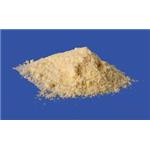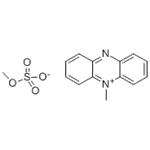
Phenazine methosulfate
- Product NamePhenazine methosulfate
- CAS299-11-6
- CBNumberCB4315528
- MFC14H14N2O4S
- MW306.34
- EINECS206-072-1
- MDL NumberMFCD00011923
- MOL File299-11-6.mol
- MSDS FileSDS
Chemical Properties
| Melting point | 158-160 °C (dec.)(lit.) |
| Density | 1.3395 (rough estimate) |
| refractive index | 1.6930 (estimate) |
| storage temp. | -20°C |
| solubility | H2O: 0.2 g/mL at 20 °C, clear, deep orange |
| form | Crystalline Powder |
| color | Dark yellow to brown or khaki |
| Water Solubility | soluble in water (approximately 200 mg/ml). |
| Sensitive | Light Sensitive |
| Merck | 14,6109 |
| BRN | 3898869 |
| Stability | Stable. Incompatible with strong oxidizing agents. |
| InChI | InChI=1S/C13H11N2.CH4O4S/c1-15-12-8-4-2-6-10(12)14-11-7-3-5-9-13(11)15;1-5-6(2,3)4/h2-9H,1H3;1H3,(H,2,3,4)/q+1;/p-1 |
| InChIKey | RXGJTUSBYWCRBK-UHFFFAOYSA-M |
| SMILES | C12C=CC=CC1=NC1=CC=CC=C1[N+]=2C.S([O-])(=O)(=O)OC |
| CAS DataBase Reference | 299-11-6(CAS DataBase Reference) |
| FDA UNII | J3GYQ3401Y |
| EPA Substance Registry System | Phenazinium, 5-methyl-, methyl sulfate (299-11-6) |
Safety
| Symbol(GHS) |

|
|||||||||
| Signal word | Warning | |||||||||
| Hazard statements | H315-H319-H335 | |||||||||
| Precautionary statements | P261-P280a-P304+P340-P305+P351+P338-P405-P501a | |||||||||
| Hazard Codes | Xi,Xn,T | |||||||||
| Risk Statements | 36/37/38-68-46 | |||||||||
| Safety Statements | 26-36/37/39-53-45 | |||||||||
| RIDADR | 2811 | |||||||||
| WGK Germany | 3 | |||||||||
| RTECS | SG1645000 | |||||||||
| F | 8 | |||||||||
| TSCA | Yes | |||||||||
| HS Code | 29339900 | |||||||||
| NFPA 704: |
|



